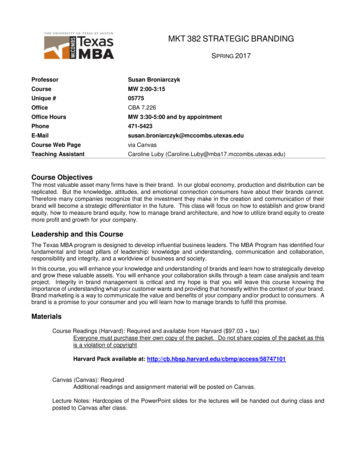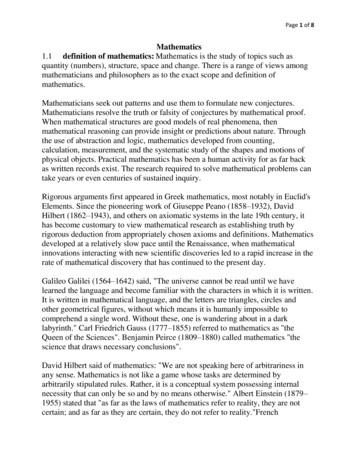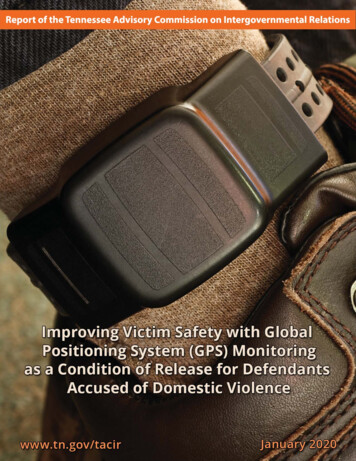
Transcription
260MATHEMATICS MAGAZINEGlobal PositioningSystem:The Mathematicsof GPS ReceiversRICHARDB. THOMPSONUniversity of ArizonaTucson, AZ 85721IntroductionGPS satellite navigation, with small hand-held receivers, is widely used by militaryunits, surveyors, sailors, utility companies, hikers, and pilots. Such units are evenavailable in many rental cars. We will consider the mathematical aspects of threequestions concerning satellite navigation.How does a GPS receiver use satellite information to determine our position?Why does the determined position change with each new computation, even thoughwe are not moving?What is done to improve the accuracy of these varying positions?We will see that receivers use very simple mathematics, but that they use it inhighly ingenious ways.Being able to locate our position on the surface of the earth has always beenimportant for commercial, scientific, and military reasons. The development ofnavigational methods has provided many mathematical challenges, which have beenmet and overcome by some of the best mathematiciansof all time.Navigation by means of celestial observation, spherical trigonometry, and handcomputation had almost reached its present form by the time of CaptainJames Cook's1779 voyage to the Hawaiian Islands. For the next 150 years these methods were usedto determine our location on land or sea. In the 1940s electronic navigation beganwith the use of fixed, land-based, radio transmitters. The present-day LOng RAngeNavigation (LORAN-C) system uses sequenced chains of such transmitters.The use of satellites in navigationbecame common in the 1970s, with the introduction of the Navy Navigation Satellite System (NAVSAT or TRANSIT). This systemuses the Doppler shift in radio frequencies to determine lines of position andlocations.The SatellitesAlmost all satellite navigation now uses the Global Positioning System (GPS). Thissystem, operated by the United States Department of Defense, was developed in the1980s and became fully operational in 1995. The system uses a constellation ofsatellites transmittingon radio frequencies, 1227.60 mHz and 1575.42 mHz.The original design of the system provided for eighteen satellites, with threesatellites in each of six orbits. Currently, there are four satellites in each orbit. In thebasic plan, the six orbits are evenly spaced every 600 around the Earth, in planes thatMathematical Association of Americais collaborating with JSTOR to digitize, preserve, and extend access toMathematics Magazine www.jstor.org
261VOL. 71, NO. 4, OCTOBER 1998FIGURE 1The Systemof Satellites.are inclined at 550 from the Equator. Orbits are circular, at a rather high altitude of20,200 kilometers above the surface of the Earth, with periods of twelve hours.FIGURE 1 displays one configuration of the basic eighteen satellites. Although notdrawn to scale, it gives the correct feeling that we are living inside a cage of orbitingsatellites, several of which are "visible" from any point on the surface of the Earth atany given time.ReceiversCurrent GPS receivers are electronic marvels. They are hand-held, run on smallbatteries, weigh as little as nine ounces, and can cost under 150. We can turn on areceiver at any point on or above the surface of the Earth and, within a few minutes,see a display showing our latitude, longitude, and altitude. The indicated surfaceposition is usually accurate to within 100 meters, and the altitude is usually in error byno more than 160 meters.How does a small radio receiver listen to a group of satellites, and then compute ourposition, with great accuracy? We start by noting exactly what sort of information isreceived from the satellites. Each satellite sends signals, on both of its frequencies,giving (i) its position and (ii) the exact times at which the signals were transmitted.The receiver also picks up time signals from the satellites, and uses them tomaintain its own clock. When a signal comes in from a satellite, the receiver recordsthe difference, At, in the time at which the signal was transmitted and the time atwhich it was received. If the Earth had no atmosphere, the receiver could use thespeed, c, of radio waves in a vacuum to compute our distance d c At from theknown position of the satellite. This information would suffice to show that we arelocated at some point on a huge sphere of radius d, centered at the point from whichthe satellite transmitted. However, the layer of gasses surrounding the Earth slowsdown radio waves and, therefore, distorts the measurement of distance. Receivers canpartially correct for this by allowing for the effect of mean atmospheric density andthickness. Information from several satellites is combined to give thecoordinates-latitude, longitude, and altitude-of our position in any selected reference system.Several factors restrict the accuracy of this process, including: (i) errors in thedetermined positions of the satellites; (ii) poor satellite positioning; (iii) limitations on
MATHEMATICS MAGAZINE262the precision with which times and distances can be measured; and (iv) the vaxyingdensity of Earth's atmosphere and the angles at which the radio signals pass throughthe atmosphere. Some of these difficulties are overcome by the use of an ingeniousplan that provides the key to GPS technology. It is rather complicated to explore thismethod in the actual setting of positioning on the Earth: The distances are large, thetime differences are small, and the geometry is all in three dimensions. Fortunately,we can capture most of the salient features of GPS receiver operation in a simpletwo-dimensional model.A Simple ModelSuppose that you are standing somewhere in a circularlot, with a radius of 100 ft. Thelot is paved, except for an irregularly-shapedgravel plot that surroundsyou. The meandistance from your position to the edge of the gravel is 20 ft. Cars circle the lot on aroad. To determine your position, messengers leave from cars on the road and walkstraight toward you. When such a messenger arrives, he tells you where and at whattime he left the road. You have a watch and know that all messengers walk at a rate of5 ft/sec on pavement but slow down to 4 ft/sec on gravel. Our model is shown inFiGURE2.\ PavementfC ravrel]10 fFIGURE2The Model.Consider a rectangular coordinate system with its origin at the center of the lot.Distances will be measured to tenths of a foot, and time will be measured to tenths ofa second. The location of a point on the road will be described by its angular distancefrom due north, measured in a clockwise direction.At noon a messenger leaves a position 45? from north. When he arrives, your watchshows that it is 20.2 seconds after noon. Since you have no way to know the exactdistance that he walked on the gravel, you assume that he covered the mean distanceof 20 ft. At 4 ft/sec, this took him 5 sec. For the remaining 15.2 sec he walked onft x 15.2 sec 76.0 ft.Allowing for the assumed distance of 20pavement, covering 5ft on the gravel, you know that you are located at some point on a circle of radius 96.0ft, centered at the starting location of the messenger.
263VOL. 71, NO. 4, OCTOBER 1998A second messenger leaves the road at a point 1350 from north at 12:01 pm andwalks to your position. On his arrival,your watch shows that it is 29.5 sec after hestarted. Assuming that he took 5 sec to walk 20 ft on the gravel, he walked 5 ft/sec24.5 sec 122.5 ft on the pavement. Hence, you are on a circle of radius 142.5 ft,centered at this messenger's point of departure.The coordinates of the departure points for the two messengers are P1 (100sin450, 100 i cos450) and P2 (100 sin 1350, 100 cos 1350), respectively.Using ourprecision of one tenth of a foot, these are rounded to (70.7 70.7) and (70.7,- 70.7).Thus, the coordinates (x0, yo), of your position satisfy{(xO - 70.7)2 (yo(xo-70.7)2 (yo -70.7)296.0270.7)2142.52JThe system has two solutions, ( - 20.0, 39.2) and (161.4,39.2), rounded to tenths.Since the latter point is outside of the lot, you can conclude that you are located 20.0ft west and 39.2 ft north of the center of the lot. The situation is shown in FIGURE 3.PIpi(xo,yo)P.,FIGURE 3TwvoMessengers.P3FIGURE 4Three Messengers.So far so good. Suppose that, just to be careful, you decide to check your positionby having a third messenger leave the road at a point 1800 from north and walk toyour location. He leaves at 12:02 pm and, according to your watch, arrives 32.2 seclater. As before, you compute your distance from this departure point P3. FIGURE 4shows the result of adding information from the third messenger to your picture.What has happened? The mnostlikely problem is that your watch does not agreewith the times used at the departure points on the road. Suppose that your watch runssteadily but has a fixed error of e seconds, where a positive e means that your watchis ahead of the road times and a negative e means that your watch is behind the roadtimes. If we let At be the time difference between departure and arrival,as shown onyour watch, then the estimate for the distance traveled isd(At, e) 20 ft (At sec - e sec - 5 sec)5 ftsecThus, the radius of each circle is in error by the same amount, -5 e ft, and theremust be a value of 8 for which the three circles have a common point. FIGURE 5 showsthe effect of various watch errors.
264MATHEMATICS MAGAZINEP.P2e -1lsecP. p.,e-1secE 5secP3PIE 4 secE 3 secP*32P3p2p(P/2pp2E 7secE 6secE 9secFIGURE 5Effect of Watch Error.It appears that your watch has an error of approximately5 sec. The error and thecoordinates of your position are a solution for the following system of equations:(( y0 - 70.7)2 d(20.2,8)270.7)2 ( y0 70.7)2 d(29.5,8)2xo - 70.7)2(x- ( xo - 0.0)2 ( yo 100.0)2) d(32.2, )2 )The system can be solved numerically, starting with seed values of 0 for e andestimated coordinates of your position for x0 and yo. There is only one solution givinga location inside of our lot. Rounding this to our level of precision yields (x0, yo, 8) (10.9,31.2,4.9). You conclude that you are 10.9 ft east and 31.2 ft north of the centerof the lot, and that your watch is 4.9 sec fast. You note the coordinates of yourposition, and discard the watch error, which is of no further interest to you.As this example of our GPS model shows, you can use time difference informationfrom three messengers to determine your position, relative to a coordinate system inthe lot. The only tools needed for this effort are a steady, but not necessarily accurate,watch and the ability to approximate the solution of a system of three equations inthree unknowns.Backto the SatellitesOur "lot" is now the region inside of the satellite orbits (including the Earth), "carsonthe road" are satellites, "messengers" are radio waves, and "gravel"is the Earth'satmosphere. We take the center of the Earth as the origin in our coordinate system.Working in three dimensions, we need information from four satellites. Call these S1,S2, S3, and S4; and suppose that Si is located at (Xi, Yi, Zi) when it transmits a signalat time Ti. If the signals are received at times Ti', according to the clock in ourreceiver, we let Ati Ti'- Ti, and let e represent any error in our clock's time. Thereceiver allows for the mean effects of passage through the Earth's atmosphere and
265VOL. 71, NO. 4, OCTOBER 1998computes distances d(Ati, 8) that indicate how far we are from each of the satellites.Our position (x0, yo, z0) is located on each of four huge spheres. In most situations,there will be only one sensible value of e that allows the spheres to have a point incommon. Our location is determined by solving a system equations.(xo(XI2yX2 ((zo( yo)2 ( XO- X2( Yo) Z2 d(Atl,)2 d(At2,y2)2 ( Zo - Z28)28)2)2 - Y3)2( YCOl( xo - X3 ( ZO Z3)2 d( At3, 8)2(x -X4) 2 ( yO - Y4)2 ( zO- Z4) d(At4, 8 JWhen a numerical solution is found, the rectangular coordinates (x0, Yo'Z0) areconverted into the essentially spherical coordinates of latitude, longitude, and altitudeabove sea level.As a practical matter, there are times and locations when a GPS receiver canreceive usable data from only three satellites. In such cases, a position at sea level canlstill be found. The receiver simply substitutes the surface of the Earth for the missingfourth sphere.To summarize our results so far, the receiver is expected to (i) receive time andposition information from the satellites, (ii) maintain a steady (but not necessarilyaccurate clock), (iii) select four satellites with a good range of positions, (iv) find anapproximate numerical solution for a system of four equations, and (v) make atransformationof coordinates. Given the current state of electronics, these are easytasks for a small hand-held instrument.Variability of PositionsOur second question about GPS positioning causes a great deal of discussion andconfusion among those who use the system. If a person stands in one fixed locationand determines repeated positions with a receiver, the coordinates of these positionstvill vary over time. Since the observer's location has not changed, the changingpositions are often attributedto alterationof the satellite signals by the Department ofDefense. The Department does, at times, degrade the satellite data and cause a loss ofGPS accuracy. This Selective Availability (SA) will be phased out within the next fewyears. (It is stated that SA is used for reasons of national security.) However,manipulation of the signals explains very little of the variation in positioning. Thevariation is primarily caused by random errors in measurement, the selection ofdifferent satellites, and by the effects of the atmosphere. We will illustrate theseproblems by returning to our simple 2-dimensional model.In our example, you determined that the coordinates of your position were(10.9,31.2) and that your watch was 4.9 seconds fast. Suppose that these values areexactl? correct. After a couple of minutes you again use three messengers todetermine your location. This time the first messenger leaves from the road at a pointthat is 47.2? from north. Rounding to your level of precision, you record the departurepoint as P1 (73.4,67.9). In this case we will assume that your information on thelocation of the departure point is not quite correct, and that the messenger actuallyleft from Q, (74.1340,67.3568). This is only a 1.0% error in the first coordinate anda 0.8% error in the second coordinate. Suppose also that the messenger actuallyencountered 25.9 ft of gravel on his way to your position.
266MATHEMATICS MAGAZINEKeeping track of 6 places, the distance from Q( to your location is 72.841286 ft.Covering the 25.9 ft of gravel at 4 ft/sec took the messenger 6.475000 sec, andcovering the 46.941286 ft of pavement at 5 ft/sec took 9.388257 sec. The actualwalking time was 15.863287 sec, which with your watch error of 4.9 sec, is 20.763257sec. Using the allowed one place of precision, you would note At 20.8 sec. Recallthat, as you stand in the lot, you have no way of knowing the amount of gravel overwhich a messenger has walked. Hence, you always assume the mean distance of 20 ft.Under this assumption, the messenger would take 5 sec to cover the gravel, leaving15.8 sec to walk on the pavement. At 5 ft/sec he would cover 79.0 ft. You concludethat the messenger has traveled 99.0 ft, and that you are at that distance from P1.To find your position, messengers leave from the road at points 138.5? and 8.10from north. You record these departure points as P2 (66.3, - 74.9) and P3 (14.1,99.0). Now suppose that your information is slightly incorrect, and that thedeparture points are actually Q2 (66.8404, - 75.6490) and Q3 (13,9731,98.0100).In addition, assume that the second messenger walked over 22.1 ft of gravel and thatthe third messenger walked over 12.0 ft of gravel. Working in the same way as you didfor the first messenger, you record time differences of 30.1 sec and 18.9 sec for thesecond and third messengers, and solve the following system of equations.(xo - 73.4)2 ( yo- 67.9)2 d(20.8, 8)2( xo - 66.3)2 ( yo (xO -74.9)214.1)2 ( yo 99.0)2 d(30.1,8)2 d(18.9,8)2)The solution, when rounded, gives your location as (xO, Yo) (5.4,32.3) and yourwatch error as 4.4 sec. Small errors in the location of the departure points, variationinthe amount of gravel covered, and the rounding of numbers to one-place haveproduced a "position"that is 5.61 ft from your actual location of (10.9,31.2).We can let a computer simulate what happens if you stay in your fixed location andmake repeated computations of your position. Each determination of a position ismade with the following assumptions.(i) Three points of departure for messengers arepicked at random, assuming that the angle between any two points of departure is atleast 30?, but not more than 150?. (ii) The distance over which a messenger must walkon gravel is a normal random variable with a mean of 20 ft and a standarddeviation of5 ft. (iii) The relative error in each coordinate of the point of departure is a normalrandom variable, with a mean of 0 and a standard deviation of 0.3%.It is common to discuss accuracy of positioning in terms of circular errors ofprobability (c.e.p.). The n% c.e.p. is the distance, d 1, such that the probabilityof anerror that is less than or equal to dn is n%. A set of 1,000 simulated positions allowedus to estimate c.e.p.'s for our model. We found d50 2.11 ft and d95 7.69 ft. (It isinteresting to note that one simulated position was 16.9 ft from the correct location.)The positions computed in a run of 50 simulations are plotted on the left side ofFIGURE 6, along with circles of radii d50 and d95. Our probabilistic model yieldsresults that agree quite well with plots of successive positions found with an actualGPS receiverfrom a fixed location.Commercially available GPS units operate under what is called the StandardPositioning Service (SPS), measuring distances using satellites' 1575.42 mHz frequency. Under the best circumstances, the 50% c.e.p. for the SPS is 40 meters. As wementioned, selective availabilityadds a small amount of random error into the SPS. Atalmost all times the 50% c.e.p. is no more than 100 meters, with a common valuebeing around 50 meters. Under these conditions, the 95% c.e.p. for SPS is
267VOL. 71, NO. 4, OCTOBER 1998i\xDouble/MessengersSingleMessengers0 2 4 6 8 10FeetFIGURE 6Simulations.approximately 100 meters. As in our model, almost all of the variability in SPSpositions comes from random errors that are inherent in the components of thesystem.PPSand DifferentialGPSWhat is done to removesomneof the random errorsfrom GPS positions? At the presenttime, there are two common methods of improving GPS accuracy. One of these is thePrecise Positioning Service (PPS), which is available for governmental use only. Thisuses signals transmitted on both of the GPS frequencies to eliminate much of thevariability caused by the Earth's atmosphere. Just as with various colors of light inthe visible spectrum, the reduction in the speed of a radio wave as it passes throughthe atmosphere depends upon its frequency. Hence, measurements of the arrivaltimes of two signals of different frequencies can be used to greatly improve theaccuracy of our distance estimates.As before, the situation is most easily understood in terms of our simple two-dimensional model. To model the PPS we will suppose that each messenger is accompaniedby an assistant, who also walks at 5 ft/sec over pavement. However, while themessenger walks at 4 ft/sec over gravel, the assistant is slowed to 3 ft/sec whenwalking on gravel. We will return to our first example of the variabilityof positionsand see what improvement in accuracy results from knowledge gained with assistantmessengers.Recall that your location in the lot has coordinates (10.9, 31.2), and that your watcherror is 4.9 sec. The first messenger departed from Q, (74.1340,67.3568) andwalked over 25.9 ft of gravel while covering the 72.841286 ft to your position. Withyour watch error, you recorded a time difference of At 20.8 sec.The assistant messenger will require 8.633333 sec to cover the 25.9 ft of gravel at 3ft/sec and 9.388257 sec to cover the paved part of the route at 5 ft/sec. Hence, histotal walking time will be 18.021591 sec. Due to the error in your watch and theallowed level of precision, you record an elapsed time of As 22.9 sec for theassistant messenger. The time differences for the messenger and the assistantmessenger give you enough information to estimate the amount of gravel that lies betweenyou and the point of departure on the road, and to estimate the total distance fromyour location to the point of departure. If we let G be the number of feet of gravel
MATHEMATICS MAGAZINE268and let D be the total distance, in feet, then we have the following system of linearequations:{20.8 D-G5 G422.9 D-G5 G3Solving the system at your level of precision, you conclude that the messenger andhis assistant crossed 25.2 ft of gravel, and came 97.7 ft from their point of departure.Thus, as best you can tell, you are at some point on a circle of radius 97.7 ft, centeredat the nominal point of departure P1 (73.4,67.9).Similarly,suppose the second and third messengers also have assistants. Computations similar to those above show that the second messenger traveled 144.8 ft,including 22.8 ft over gravel, and that the third messenger traveled 91.5 ft, including12.0 ft over gravel. (These values include any possible watch error.) Your estimate forthe actual distance that a messenger has traveled is now a function of the distance, G,of gravel covered; the time difference, At; and your watch error, 8.d(G, At, 8) G ft At sec- 8sec-G ftftft5 secThis distance formula and the three points of departure lead to a system ofequations whose solution (x0, yo, s) gives an estimate of the coordinates for yourposition and for the error of your watch.t(x0-73.4)2 ( yo - 67.9)2 d(25.2, 20.8, 8)2( x0 - 66.3)2 ( y0 74.9)2 d(22.8, 30.1,( x0 -14.1)2 ( yo 99.0)28)2. d(12.0, 18.9, 8)2)Solving this system, at your level of precision, yields a position of (x0, yo) (9.2, 31.6) and a watch error of 4.8 sec. Your current estimate is only 1.75 ft from yourcorrect location of (10.9,31.2). This compares with an error of 5.61 ft found by usingsingle messengers.A computer-generated set of 1,000 simulationsfor positions computed with messengers and assistants gave estimates of 0.50 ft and 1.90 ft for the c.e.p.'s d50 and d95,respectively. The maximum distance of a computed position from the actual locationwas 3.41 ft. These simulations were based upon the same conditions that we used forour model of the SPS. The positions computed in a run of 50 simulations for ourmodel of PPS are plotted on the right side of FIGURE 6, along with circles of radii d50and d95. Comparison of the two sides of FIGURE 6 shows that there is a considerablegain in accuracy when most of the variation due to distance walked over gravel iseliminated.In the real world of satellites and positions on the Earth, the use of two radiofrequencies in the PPS produces considerably more accuracy than can be obtainedwith the single-frequency SPS. It is believed that the PPS has a 50% c.e.p. ofapproximately16 meters.A second method for improving the accuracy of the usual SPS locations is cominginto use at airports and major harbors. This is called the Differential Global Positioning System (DGPS). Most of the error in a GPS position is due to random variablesin
VOL. 71, NO. 4, OCTOBER 1998269the atmosphere and the satellite system. Hence, within a small geographical area, theerror at any instant tends to be independent of the exact location of the receiver.DGPS exploits this situation by establishing a fixed base station, whose exact locationis alreadyknown. Equipment at the base station computes its current "GPS position,"compares this with its known location, and continuously broadcasts a correction term.A DGPS receiver in the area receives its own satellite information and computes itsposition. Simultaneously it receives the current correction from its base station, andapplies this to its computed position. The result is a very accurate determinationof thereceiver's position; 50% c.e.p.'s for GDPS run close to 9 meters.ConclusionsThe very ingenious idea of leaving clock error as a variable allows a GPS receiver todisplay our position on the Earth at any location and at any time, using nothing morethan simple algebra. The variations in computed positions are almost entirely due toinherent limitations on precision within the system. A second clever plan allows theuse of two radio frequencies to eliminate much of the variabilitycaused by the passageof signals through the Earth's atmosphere.REFERENCES1. Nathaniel Bowditch, American Practical Navigator, Defense Mapping Agency Hydrographic/Topographic Center, 1984.2. GPS Global Positioning System, a supplemental program produced by the United States PowerSquadrons, 1995.3. Product information, West Marine, Inc., 1997.4. United States Coast Guard navigationweb site, http: //www.navcen.uscg.mil/
RICHARD B. THOMPSON University of Arizona Tucson, AZ 85721 Introduction . Almost all satellite navigation now uses the Global Positioning System (GPS). This system, operated by the United States Department of Defense, was developed in the 1980s and became fully operational in 1995. The system uses a constellation of










